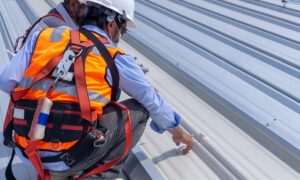Building envelope maintenance is one of the most important parts of commercial property maintenance. Neglect could result in sustained heat and water damage, affecting the property’s energy efficiency and indoor air quality. It could also lead to safety issues, which could result in a lawsuit.
What is a Building Envelope?
The building envelope includes all the structures that divide the outside and inside of the building. It is a thermal and physical barrier that separates the indoors from the outdoors, protecting the interior from the sun, wind, rain, and other elements.
The key components of a building envelope include the walls, foundation, and roof. In commercial buildings, these components are more complex. The envelope includes many layers, such as roof and wall insulation, roof and wall framing, coping cap joints, masonry walls, through-wall flashing and barriers, expansion joints, doors, and windows.
Why is the Building Envelope Important?
It can be tempting to neglect the building envelope once a structure is built. However, it’s critical to maintaining the property’s stability and safety. It determines whether the place is habitable, beautiful, and comfortable.
A good foundation, wall, and roof will resist the forces of an earthquake to protect the people and property inside. In case of a fire, these systems act as a way to contain the smoke and prevent fire from spreading.
Even if your area is not prone to earthquakes and fires, the building envelope still plays a vital role daily. It manages the vapor, heat, and air quality within the building. These must be well-regulated to protect the parts from heat and water damage.
Moreover, the building envelope helps the building remain energy efficient. If it’s in poor condition, the building won’t be able to regulate heat as well, forcing the HVAC system to work harder. Additionally, parts of the building envelope are essential to the property’s aesthetic appeal.
Finally, maintaining the building envelope is important in protecting your investment. It prolongs the life of the building and ensures it meets construction standards.
What is Building Envelope Maintenance?
Building envelope maintenance is the process of maintaining elements of the building envelope to protect the structure’s overall stability and quality. It could involve building envelope repairs, replacing broken parts and materials, and addressing minor issues before they turn into significant damage. How do you maintain it? Here are some guidelines to help you.
1. Maintaining the Roof
 The roof plays a critical role in protection and insulation. Regular visual surveys are important to spot openings and deterioration. Property owners should also conduct infrared surveys of the roof every five years.
The roof plays a critical role in protection and insulation. Regular visual surveys are important to spot openings and deterioration. Property owners should also conduct infrared surveys of the roof every five years.
Roof maintenance will depend on the type of roof built onto the structure. Some flat roofs require more maintenance, while others remain stable even with less frequent inspections. Single-ply roof membranes are usually easier to repair compared to built-up roofing.
Regardless of the issue, it’s best to call a professional if you spot any damage to the roof. They can assess the damage and make immediate repairs to prevent minor issues from escalating.
2. Checking the Windows and Glazing
A visual survey of the wall system components, sealants in window perimeters and wall systems, and window glazing gaskets should be conducted regularly. A professional should address any sign of damage. Sometimes, you must make repairs or replacements because the window is outdated, does not serve your needs, or is poorly insulated.
3. Insulation Inspection
Property owners should regularly check the building for ventilation issues, humidity, and minor leaks. These usually mean parts of the property are ineffective or have sustained damage. Even the smallest insulation sections might need replacement, as they can easily lead to substantial heat leaks.
4. Replacing the Caulking
All kinds of caulking will dry over time, leading to cracks and crumbles. Make sure to replace the damaged caulking on every door, window, and other parts of the property that have it.
 5. Refreshing the Paint
5. Refreshing the Paint
Paint can make or break a building’s aesthetic appeal. A poor paint job can deter customers and harm the company’s reputation. In contrast, a good paint job or a fresh coat of paint can pique people’s interest and invite more patrons.
Signs of a Failing Building Envelope
Leaving minor issues unaddressed can result in significant consequences and costly restorations. Unfortunately, spotting minor issues is not always easy, especially if they’ve just begun to form. As a property owner, you must familiarize yourself with the common signs of failure in the building envelope. Here are some tell-tale signs to watch out for:
- Faulty heat seals in the windows
- Damage to the ventilation systems, caulk, and insulation
- Moisture and other elemental breakthroughs within the property
- Incidental water leakage
Protecting the Building Envelope
Preventive maintenance is usually better than reactive maintenance. Taking these measures can prevent failure and help the building last longer. Here are some precautionary steps to protect the building envelope’s structural integrity and efficiency.
1. Invest in High-Quality Materials
To prevent failures, property owners should make it a point to invest in durable and high-quality construction materials. Choose parts and materials that are low-maintenance and moisture-resistant. Air barriers can also protect the property and serve as an additional layer of defense from the elements.
2. Waterproof the Roof
The roof is your first defense against rain, snow, and other elements that can cause water damage. Once water has entered the building through the roofing system, it usually compromises the different building envelope components. Make sure to reinforce the roof with waterproofing. Regular maintenance will also ensure the warranty of the materials remains intact.
 3. Hire Certified Professionals
3. Hire Certified Professionals
Remember to hire only certified installers and repair contractors when inspecting, installing, or repairing any part of the property.
Hiring third parties without certification might be cheaper, but it could also void your warranty. Plus, they might use unsafe techniques or low-quality materials.
4. Address the Drainage
Poor drainage can cause significant water damage to the property’s foundation and walls. Ensure the ground slopes away from the building to prevent water from building up. Moreover, we recommend using a system that redirects runoff and facilitates drainage on both the roof and vertical parts of the building. Water should have a clear exit path without obstacles.
5. Use Window Flashings
Window flashings must be installed and maintained to prevent window leaks. Caulk and sealants must be reapplied regularly. Remember to also use high-quality materials, as they can last decades before deteriorating.
6. Prioritize the Air Barrier
Air leakage compromises indoor air quality and energy efficiency. Construct a reliable and continuous air barrier to reduce the amount of unintended air that goes in and out of the property.
7. Insulate the Building
The sun’s radiant heat can significantly affect a building’s thermal gains and thermal bridging. Proper insulation techniques can enhance the building’s performance and keep energy costs low.
The Bottom Line
Building envelope maintenance is often neglected, but it is essential to commercial property maintenance. Regular inspections, preventive maintenance, and addressing issues as they arise will help you keep repair costs down and prolong the property’s life expectancy.
Maintenance Specialists Inc. provides world-class commercial property maintenance. Call us today at 704.405.6000 or get in touch online to learn more!
RELATED ARTICLES:
- What Is Proper Commercial Stairs Maintenance?
- 8 Reasons Why Commercial Roof Cleaning Is A Must
- Commercial Handrail Repair And Maintenance

